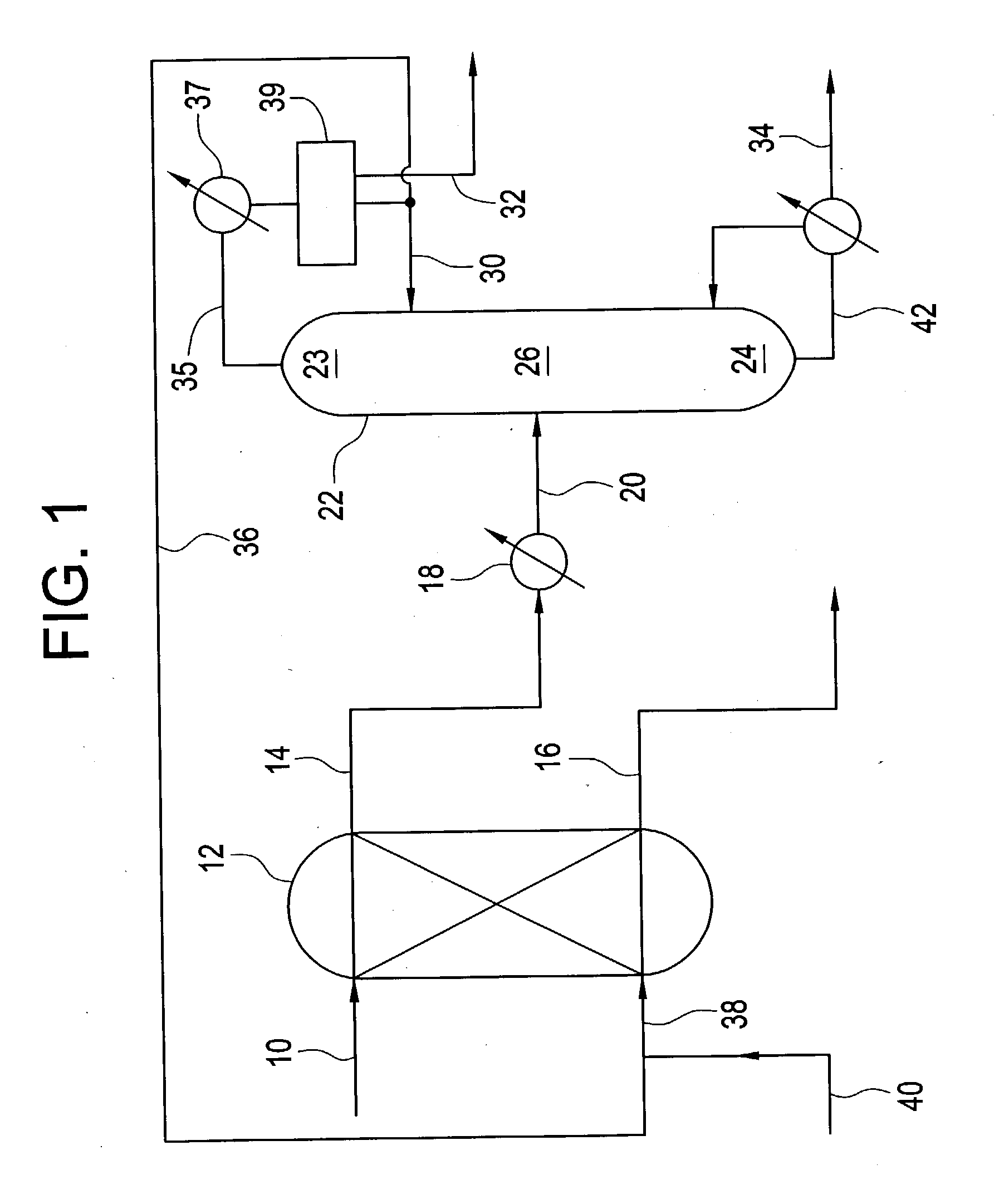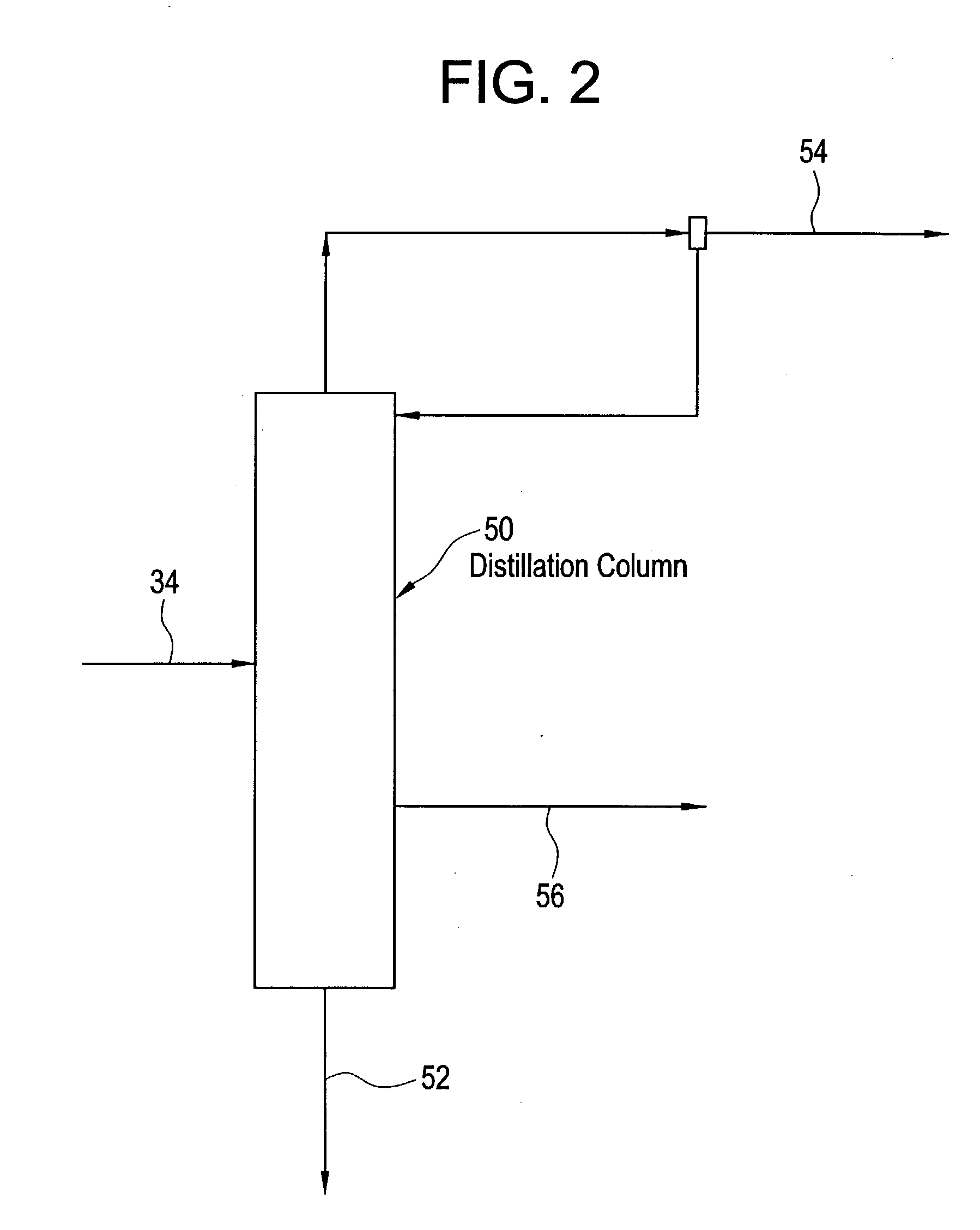Acrylic acid recovery utilizing ethyl acrylate and selected co-solvents
a technology of acrylic acid and co-solvents, applied in the field of recovery of acetic acid, can solve problems such as the problem of removing close-boiling impurities, especially acetic acid, and achieve the effect of reducing the number of acetic acid residues
- Summary
- Abstract
- Description
- Claims
- Application Information
AI Technical Summary
Benefits of technology
Problems solved by technology
Method used
Image
Examples
examples 3-8
[0060] Following the procedure of Examples 1-2 and Comparative Example A, extractions were carried out using mixed ethyl acrylate / toluene solvent systems. Results appear in Table 2 below.
2TABLE 2 Extraction Using Ethyl Acrylate / Toluene Mixture In Various Proportions Wt. Of 34% Wt. Of Type of Acrylic Acid Solvent Sample Analytical Results Distribution Example Sample (g) (g) Wt. (g) % EA % Toluene % HACA % H.sub.2O Coeff Selectivity -- 34% X x X x x 33.34 68.05 HACA Extraction using 80 / 20 mixture of EA / Tol. -- EA / Tol. X x X 80.38 22.29 x x Mix 3 Aqueous 50.0 50.0 29.1 2.06 0.01 10.23 88.85 1.7138 6.8364 3 Organic 50.0 50.0 67.5 63.53 17.64 17.53 2.56 4 Aqueous 50.0 50.0 33.2 2.09 0.01 10.16 87.07 1.7676 3.3948 4 Organic 50.0 50.0 66.5 62.02 16.85 17.96 5.29 Extraction using 90 / 10 mixture of EA / Tol. -- EA / Tol. X x X 90.55 11.24 x x Mix 5 Aqueous 50.0 50.0 31.8 2.19 0.00 9.35 87.13 1.9018 2.7038 5 Organic 50.0 50.0 67.9 69.71 8.64 17.79 6.58 6 Aqueous 50.0 50.0 31.6 2.22 0.00 9.44 88.33...
example 21
[0070] An aqueous stream composed of 34.99% by weight acrylic acid, 2.5% by weight acetic acid, and 62.44% by weight water is fed to the top of a counter-current extractor at a rate of 5.2 g / min and contacted with a solvent composed of 1.9% by weight acrylic acid, 1.38% by weight acetic acid, 85.33% by weight ethyl acrylate, 2.1% by weight water, and 9.29% by weight toluene, entering at the bottom of the extractor at a rate of 3.98 g / min. The extraction was performed with approximately 6 theoretical stages. The aqueous raffinate contained 2.5% by weight acrylic acid, 2.6% by weight acetic acid, 1.9% by weight ethyl acrylate, 92.99% by weight water, and 0.004% by weight toluene. The organic extract, composed of 27.38% by weight acrylic acid, 1.6% by weight acetic acid, 54.08% by weight ethyl acrylate, 10.7% by weight water, and 6.2% by weight toluene, was fed to a 20-tray one inch diameter Oldershaw distillation column at a rate of 6.2 g / min. The pressure at the top of the column was...
example 22
[0076] A crude Acrylic Acid solution, composed of 98.03% by weight acrylic acid, 0.87% acetic acid, 0.51% Ethyl Acrylate, 0.34% Dimer, 0.03% Furfural, 0.04% Propionic Acid, 0.03% Benzaldehyde, 0.03% Toluene, 0.07% H.sub.20 and 0.05% PTZ is preheated to 55.1 C. and fed to the 10.sup.th tray of a 20-tray one inch Oldershaw distillation column at a rate of 3.09 g / min. The overhead pressure was maintained at 100 mm Hg. The bottom of the column was equipped with a thermosiphon reboiler at the temperature of 91.5 C. The residue was taken off at the rate of 1.49 g / min and consisted of 96.05% by weight Acrylic Acid, 0.03% Acetic Acid, 0.05% Furfural, 0.04% Propionic Acid, 0.05% Benzaldehyde, 3.29% Dimer, 0.08% H.sub.2O and 0.41% PTZ. The overhead was condensed and refluxed at the rate of 3 g / min. A portion of the overhead was taken off at the rate of 0.4 g / min and consisted of 90.16% Acrylic Acid, 5.22% acetic acid, 0.03% Propionic Acid, 3.31% Ethyl Acrylate, 0.03% Dimer, 0.12% Toluene, and...
PUM
| Property | Measurement | Unit |
|---|---|---|
| wt % | aaaaa | aaaaa |
| wt % | aaaaa | aaaaa |
| wt % | aaaaa | aaaaa |
Abstract
Description
Claims
Application Information
 Login to View More
Login to View More - R&D
- Intellectual Property
- Life Sciences
- Materials
- Tech Scout
- Unparalleled Data Quality
- Higher Quality Content
- 60% Fewer Hallucinations
Browse by: Latest US Patents, China's latest patents, Technical Efficacy Thesaurus, Application Domain, Technology Topic, Popular Technical Reports.
© 2025 PatSnap. All rights reserved.Legal|Privacy policy|Modern Slavery Act Transparency Statement|Sitemap|About US| Contact US: help@patsnap.com



